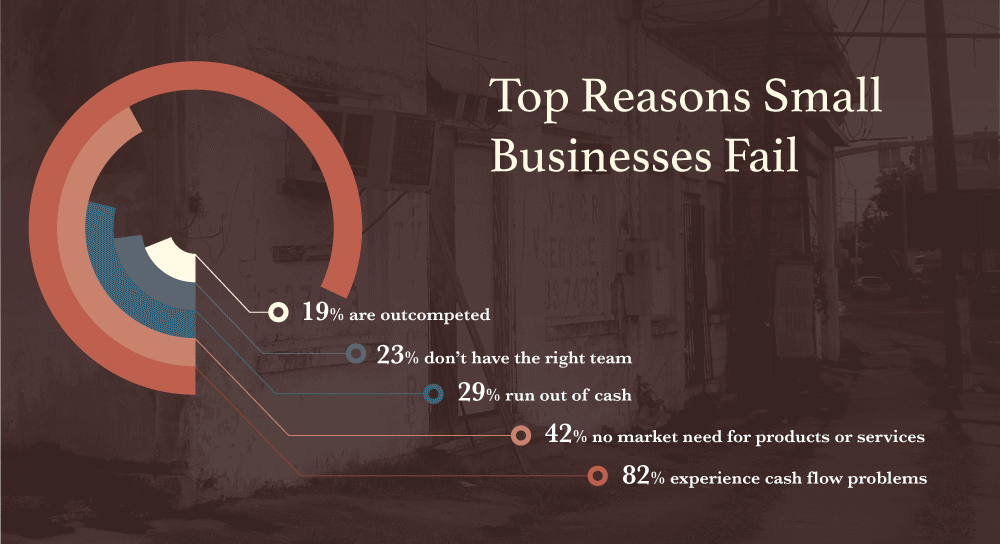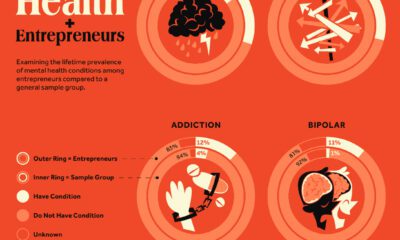Technology
Why Do Businesses Fail?

Why Do Businesses Fail?
For any new entrepreneur, it’s natural to be optimistic.
Whether that person has a world-changing idea or is starting a new coffee shop, the glass has to be half full that the business will succeed. Otherwise, what is the point of starting a new company in the first place?
The Harsh Reality
Today’s infographic from InsuranceQuotes shows that this entrepreneurial enthusiasm might be misplaced.
The reality is that it’s a cruel world out there for entrepreneurs. The Bureau of Labor Statistics in the United States keeps a sobering tally of how often businesses fail, and here are the numbers from 1995-2015:
| Years in Business | Failure Rate |
|---|---|
| 1 year | 21.2% |
| 2 years | 32.1% |
| 5 years | 51.2% |
| 10 years | 66.6% |
| 20 years | 79.6% |
Statistically speaking, there is over a 50% chance that any new business is toast in five years.
And the record for tech startups? It’s even worse, with 90% of all startups eventually failing.
Business Failure Can Be Complex
It takes the confluence of many factors to build a successful business: assembling the right team at the right time, achieving product/market fit, staying on top of the competition, and getting the necessary funding are just some of the key elements to success.
In the same vein, it is often hard to pin down just one reason for failure, since everything is so interconnected.
For example, one study by U.S. Bank shows that 82% of small businesses fail because of cash flow mismanagement. This is a fair point, since without cash flow there is no business.
However, while cash flow may end up being the final nail in the coffin for many businesses, it’s also fair to say that a lack of cash flow can be the symptom of other problems. What if the company is going after the wrong market? What if the team is dysfunctional and unmotivated? What if the company isn’t differentiated enough to compete?
With any of these situations playing out, it should be no surprise that sales aren’t coming in like expected, which would certainly tank cash flow. At the same time, a company with the right team and product should be able to make swift changes to right the ship from any chronic issues.
Some Reasons Businesses Fail
With the complexity of business failure in mind, here are some of the commonly listed reasons for why businesses fail:
- 82% experience cash flow problems
- 42% find that there is an insufficient need for their product or service
- 29% run out of cash
- 23% do not have the right team
- 19% are out-competed
Lastly, for a full list of reasons for why businesses fail, see this infographic showing 20 common reasons why startups fail.
Technology
All of the Grants Given by the U.S. CHIPS Act
Intel, TSMC, and more have received billions in subsidies from the U.S. CHIPS Act in 2024.

All of the Grants Given by the U.S. CHIPS Act
This was originally posted on our Voronoi app. Download the app for free on iOS or Android and discover incredible data-driven charts from a variety of trusted sources.
This visualization shows which companies are receiving grants from the U.S. CHIPS Act, as of April 25, 2024. The CHIPS Act is a federal statute signed into law by President Joe Biden that authorizes $280 billion in new funding to boost domestic research and manufacturing of semiconductors.
The grant amounts visualized in this graphic are intended to accelerate the production of semiconductor fabrication plants (fabs) across the United States.
Data and Company Highlights
The figures we used to create this graphic were collected from a variety of public news sources. The Semiconductor Industry Association (SIA) also maintains a tracker for CHIPS Act recipients, though at the time of writing it does not have the latest details for Micron.
| Company | Federal Grant Amount | Anticipated Investment From Company |
|---|---|---|
| 🇺🇸 Intel | $8,500,000,000 | $100,000,000,000 |
| 🇹🇼 TSMC | $6,600,000,000 | $65,000,000,000 |
| 🇰🇷 Samsung | $6,400,000,000 | $45,000,000,000 |
| 🇺🇸 Micron | $6,100,000,000 | $50,000,000,000 |
| 🇺🇸 GlobalFoundries | $1,500,000,000 | $12,000,000,000 |
| 🇺🇸 Microchip | $162,000,000 | N/A |
| 🇬🇧 BAE Systems | $35,000,000 | N/A |
BAE Systems was not included in the graphic due to size limitations
Intel’s Massive Plans
Intel is receiving the largest share of the pie, with $8.5 billion in grants (plus an additional $11 billion in government loans). This grant accounts for 22% of the CHIPS Act’s total subsidies for chip production.
From Intel’s side, the company is expected to invest $100 billion to construct new fabs in Arizona and Ohio, while modernizing and/or expanding existing fabs in Oregon and New Mexico. Intel could also claim another $25 billion in credits through the U.S. Treasury Department’s Investment Tax Credit.
TSMC Expands its U.S. Presence
TSMC, the world’s largest semiconductor foundry company, is receiving a hefty $6.6 billion to construct a new chip plant with three fabs in Arizona. The Taiwanese chipmaker is expected to invest $65 billion into the project.
The plant’s first fab will be up and running in the first half of 2025, leveraging 4 nm (nanometer) technology. According to TrendForce, the other fabs will produce chips on more advanced 3 nm and 2 nm processes.
The Latest Grant Goes to Micron
Micron, the only U.S.-based manufacturer of memory chips, is set to receive $6.1 billion in grants to support its plans of investing $50 billion through 2030. This investment will be used to construct new fabs in Idaho and New York.
-

 Education1 week ago
Education1 week agoHow Hard Is It to Get Into an Ivy League School?
-

 Technology2 weeks ago
Technology2 weeks agoRanked: Semiconductor Companies by Industry Revenue Share
-

 Markets2 weeks ago
Markets2 weeks agoRanked: The World’s Top Flight Routes, by Revenue
-

 Demographics2 weeks ago
Demographics2 weeks agoPopulation Projections: The World’s 6 Largest Countries in 2075
-

 Markets2 weeks ago
Markets2 weeks agoThe Top 10 States by Real GDP Growth in 2023
-

 Demographics2 weeks ago
Demographics2 weeks agoThe Smallest Gender Wage Gaps in OECD Countries
-

 Economy2 weeks ago
Economy2 weeks agoWhere U.S. Inflation Hit the Hardest in March 2024
-

 Green2 weeks ago
Green2 weeks agoTop Countries By Forest Growth Since 2001














